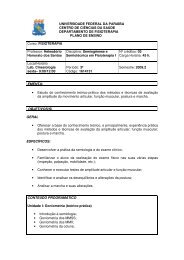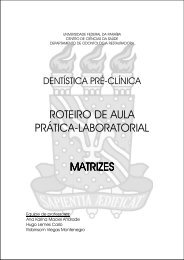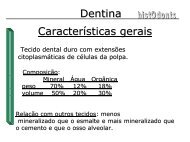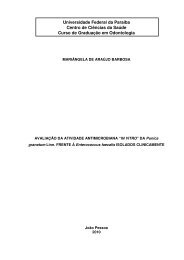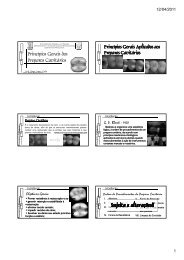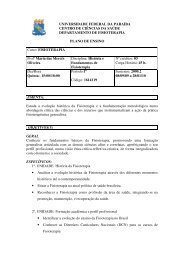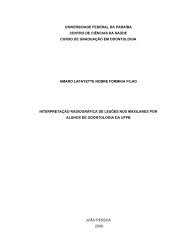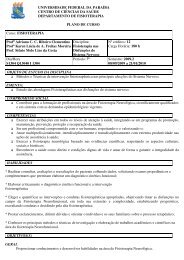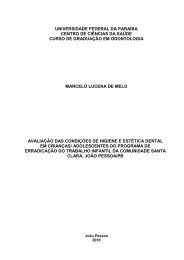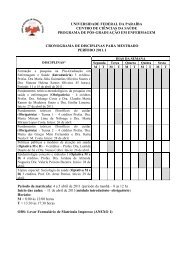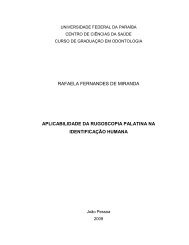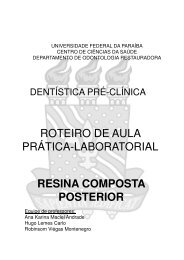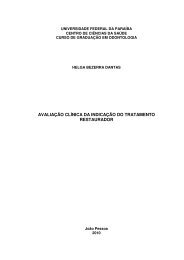An assessment of rubber dam usage amongst specialists in ... - CCS
An assessment of rubber dam usage amongst specialists in ... - CCS
An assessment of rubber dam usage amongst specialists in ... - CCS
You also want an ePaper? Increase the reach of your titles
YUMPU automatically turns print PDFs into web optimized ePapers that Google loves.
Rubber <strong>dam</strong> <strong>usage</strong> <strong>amongst</strong> <strong>specialists</strong> 55<br />
dentistry. The low rates <strong>of</strong> <strong>rubber</strong> <strong>dam</strong> <strong>usage</strong><br />
recorded <strong>in</strong> this study may then not be an<br />
accurate estimate <strong>of</strong> <strong>rubber</strong> <strong>dam</strong> <strong>usage</strong> for this<br />
particular treatment.<br />
It was reveal<strong>in</strong>g to f<strong>in</strong>d that, <strong>in</strong> relation to<br />
the barriers <strong>of</strong> RD, lack <strong>of</strong> patient cooperation<br />
was cited by respondents as the ma<strong>in</strong> factor<br />
prevent<strong>in</strong>g RD use, which concurs with previous<br />
results 15 . Other workers have looked at<br />
both operator and patient attitudes towards<br />
RD <strong>in</strong> the paediatric patient, <strong>in</strong> cases where<br />
the operator was an undergraduate 9 . All 100<br />
patients <strong>in</strong> the above study accepted RD, with<br />
79% hav<strong>in</strong>g good acceptance <strong>of</strong> RD and 30%<br />
stat<strong>in</strong>g that they preferred treatment with RD.<br />
Patient anxiety scores recorded revealed low<br />
patient anxiety regard<strong>in</strong>g <strong>rubber</strong> <strong>dam</strong> application.<br />
This would suggest that anxiety is not a<br />
universal barrier to the placement <strong>of</strong> <strong>rubber</strong><br />
<strong>dam</strong> <strong>in</strong> the paediatric patient. Equally, others<br />
have found that six out <strong>of</strong> the 10 paediatric<br />
patients <strong>in</strong>cluded <strong>in</strong> a study with<strong>in</strong> general<br />
practice preferred treatment with RD 30 . The<br />
authors <strong>of</strong> this study, however, have noted<br />
that many <strong>of</strong> the patients referred to a specialist<br />
paediatric dentist, rather than those<br />
treated by undergraduates or general dental<br />
practitioners, are secondary/tertiary referrals,<br />
those with severe dental phobia, those with<br />
learn<strong>in</strong>g difficulties or perhaps patients for<br />
whom RD is contra<strong>in</strong>dicated 33 , <strong>in</strong> which case<br />
the use <strong>of</strong> RD may prove impossible.<br />
Perhaps <strong>of</strong> more <strong>in</strong>terest, however, was that<br />
36% <strong>of</strong> respondents stated that they ‘do not<br />
feel that RD is necessary for most treatments’.<br />
As long ago as 1962, Ireland was aware <strong>of</strong> this<br />
view <strong>of</strong> <strong>rubber</strong> <strong>dam</strong>, stat<strong>in</strong>g that:<br />
‘No other technique, treatment or <strong>in</strong>strument<br />
used <strong>in</strong> dentistry is so universally advocated<br />
by the recognized authorities and so universally<br />
ignored by the practic<strong>in</strong>g dentist.’ 34<br />
Indeed, more recent reports have stated that<br />
many <strong>of</strong> the carers who accompany young<br />
patients for treatment have not seen RD previously<br />
9 , suggest<strong>in</strong>g under-use <strong>of</strong> <strong>rubber</strong> <strong>dam</strong><br />
with<strong>in</strong> the pr<strong>of</strong>ession generally, which was reflected<br />
<strong>in</strong> the respondent comments <strong>in</strong> this study.<br />
Lack <strong>of</strong> personal experience was referred to by<br />
8% <strong>of</strong> respondents as a factor prevent<strong>in</strong>g RD use.<br />
Not surpris<strong>in</strong>gly, Wolcott and Goodman found<br />
that dentists who used RD more frequently<br />
encountered fewer patient objections and<br />
came to the conclusion that either the dentists’<br />
motivation to use RD may be reflected by<br />
the presentation <strong>of</strong> RD to patients or dentists<br />
may rationalize their failure to use RD by<br />
claim<strong>in</strong>g patient resistance 35 . The section for<br />
comments cont<strong>in</strong>ued this theme <strong>of</strong> the need<br />
for further experience and tra<strong>in</strong><strong>in</strong>g <strong>in</strong> the use<br />
<strong>of</strong> RD, <strong>in</strong>clud<strong>in</strong>g the need for ‘better tra<strong>in</strong>ed<br />
nurses to properly assist its [<strong>rubber</strong> <strong>dam</strong>]<br />
placement’, this f<strong>in</strong>d<strong>in</strong>g hav<strong>in</strong>g been previously<br />
noted by other workers 11,30 . Whilst there are<br />
currently various options for tra<strong>in</strong><strong>in</strong>g <strong>in</strong> <strong>rubber</strong><br />
<strong>dam</strong> <strong>usage</strong> with<strong>in</strong> the UK, further educational<br />
opportunities are perhaps required both for<br />
dentists and dental care pr<strong>of</strong>essionals.<br />
What this paper adds<br />
• This questionnaire-based study suggests that there is<br />
under-<strong>usage</strong> <strong>of</strong> <strong>rubber</strong> <strong>dam</strong> by paediatric dentistry<br />
<strong>specialists</strong> <strong>in</strong> the UK, as compared to the suggested level<br />
<strong>of</strong> use <strong>of</strong> <strong>rubber</strong> <strong>dam</strong>, endorsed by the BSPD, for<br />
various restorative and endodontic procedures.<br />
• Respondents have highlighted the need for further<br />
tra<strong>in</strong><strong>in</strong>g <strong>in</strong> the practical application <strong>of</strong> <strong>rubber</strong> <strong>dam</strong>.<br />
• Dry Dam® is the most commonly used method for<br />
anterior teeth, as compared to clamp and <strong>dam</strong> for<br />
posterior teeth.<br />
Why this paper is important to paediatric dentists<br />
• This study has raised awareness <strong>amongst</strong> practitioners<br />
<strong>of</strong> the discrepancies <strong>in</strong> their <strong>rubber</strong> <strong>dam</strong> <strong>usage</strong>.<br />
• The paper highlights the need for further educational<br />
opportunities for <strong>rubber</strong> <strong>dam</strong> placement <strong>amongst</strong> the<br />
dental team.<br />
Conclusions<br />
Current BSPD guidel<strong>in</strong>es recommend <strong>rubber</strong><br />
<strong>dam</strong> <strong>usage</strong> for many restorative procedures and<br />
it would appear that there is wide variability<br />
<strong>in</strong> <strong>dam</strong> <strong>usage</strong> <strong>amongst</strong> <strong>specialists</strong> <strong>in</strong> paediatric<br />
dentistry work<strong>in</strong>g <strong>in</strong> the UK. Respondents<br />
cited a lack <strong>of</strong> patient cooperation as the most<br />
common factor prevent<strong>in</strong>g them from us<strong>in</strong>g<br />
<strong>rubber</strong> <strong>dam</strong>, with patient safety rated as the<br />
greatest benefit <strong>of</strong> <strong>rubber</strong> <strong>dam</strong>.<br />
Acknowledgements<br />
We would like to thank those <strong>in</strong>dividuals who<br />
were <strong>in</strong>volved <strong>in</strong> both the pilot study and the<br />
© 2006 The Authors<br />
Journal compilation © 2006 BSPD, IAPD and Blackwell Publish<strong>in</strong>g Ltd



